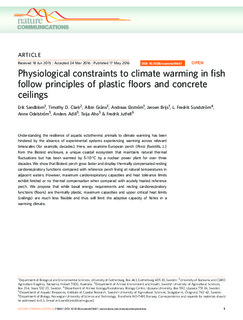| dc.contributor.author | Sandblom, Erik | |
| dc.contributor.author | Clark, Timothy | |
| dc.contributor.author | Gräns, Albin | |
| dc.contributor.author | Ekström, Andreas | |
| dc.contributor.author | Brijs, Jeroen | |
| dc.contributor.author | Sundström, Fredrik | |
| dc.contributor.author | Odelström, Anne | |
| dc.contributor.author | Adill, Anders | |
| dc.contributor.author | Teija, Aho | |
| dc.contributor.author | Jutfelt, Fredrik | |
| dc.date.accessioned | 2016-05-17T18:15:42Z | |
| dc.date.accessioned | 2016-06-09T12:44:19Z | |
| dc.date.available | 2016-05-17T18:15:42Z | |
| dc.date.available | 2016-06-09T12:44:19Z | |
| dc.date.issued | 2016-05-17 | |
| dc.identifier.citation | Nature Communications 2016, 7(11447) | nb_NO |
| dc.identifier.issn | 2041-1723 | |
| dc.identifier.uri | http://hdl.handle.net/11250/2392066 | |
| dc.description.abstract | Understanding the resilience of aquatic ectothermic animals to climate warming has been
hindered by the absence of experimental systems experiencing warming across relevant
timescales (for example, decades). Here, we examine European perch (Perca fluviatilis, L.)
from the Biotest enclosure, a unique coastal ecosystem that maintains natural thermal
fluctuations but has been warmed by 5–10 C by a nuclear power plant for over three
decades. We show that Biotest perch grow faster and display thermally compensated resting
cardiorespiratory functions compared with reference perch living at natural temperatures in
adjacent waters. However, maximum cardiorespiratory capacities and heat tolerance limits
exhibit limited or no thermal compensation when compared with acutely heated reference
perch. We propose that while basal energy requirements and resting cardiorespiratory
functions (floors) are thermally plastic, maximum capacities and upper critical heat limits
(ceilings) are much less flexible and thus will limit the adaptive capacity of fishes in a
warming climate | nb_NO |
| dc.language.iso | eng | nb_NO |
| dc.publisher | Nature Publishing Group | nb_NO |
| dc.rights | Navngivelse 3.0 Norge | * |
| dc.rights.uri | http://creativecommons.org/licenses/by/3.0/no/ | * |
| dc.title | Physiological constraints to climate warming in fish follow principles of plastic floors and concrete ceilings | nb_NO |
| dc.type | Journal article | nb_NO |
| dc.type | Peer reviewed | nb_NO |
| dc.date.updated | 2016-05-17T18:15:42Z | |
| dc.source.volume | 7 | nb_NO |
| dc.source.journal | Nature Communications | nb_NO |
| dc.identifier.doi | 10.1038/ncomms11447 | |
| dc.identifier.cristin | 1355933 | |
| dc.description.localcode | This work is licensed under a Creative Commons Attribution 4.0 International License. The images or other third party material in this article are included in the article’s Creative Commons license, unless indicated otherwise in the credit line; if the material is not included under the Creative Commons license, users will need to obtain permission from the license holder to reproduce the material. To view a copy of this license, visit http://creativecommons.org/licenses/by/4.0/ | nb_NO |

